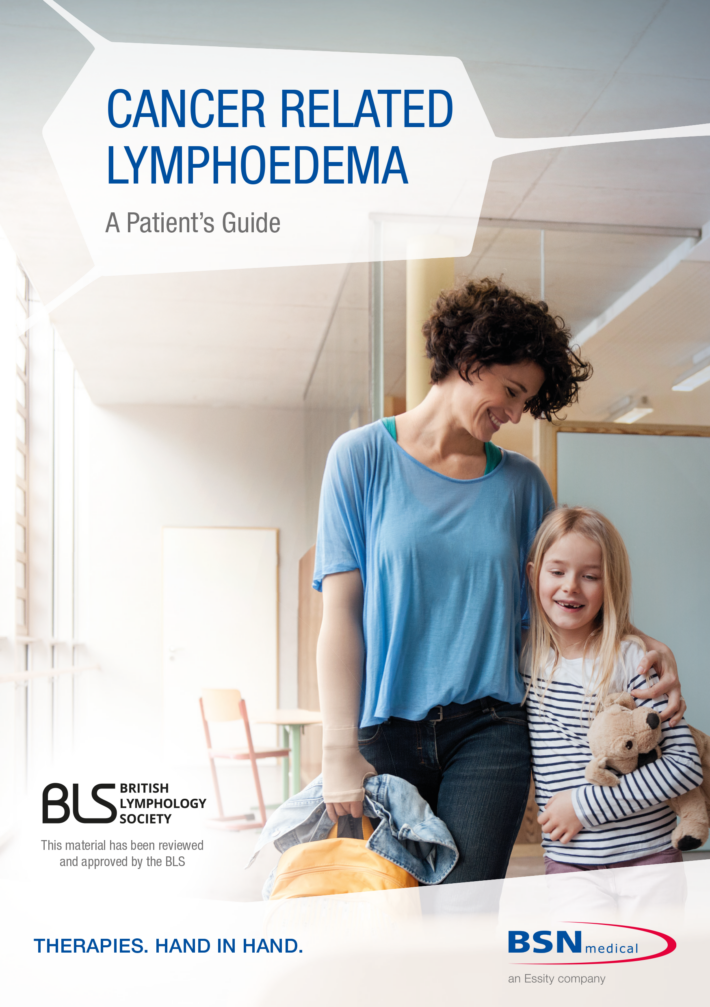We are pleased to add a new resource to our website, which has been sponsored by one of our Platinum Partners, BSN Medical and reviewed and approved by the British Lymphology Society (BLS).
What does the guide contain?
What is Lymphoedema?
Lymphoedema results from a failure of the lymphatic system. Consequences are swelling, skin and tissue changes and a risk of infection. It most commonly affects the lower or upper limbs, but may also affect midline structures such as the face, neck, trunk, breasts or genitalia.
When the lymphatic system is not working properly, extra lymph fluid can overload it and lead to the development of lymphoedema.
This may happen when the lymphatic system is obstructed or damaged, for example; surgical removal of lymph nodes. Lymphoedema is a chronic condition that never goes away because the lymphatic system can not repair itself. However with the right diagnosis and prompt treatment lymphoedema can be well managed.
What is the lymphatic system?
It is important to understand what the lymphatic system is and it’s function within the body.
The lymphatic system is a network of lymph vessels and lymph nodes that rid the body of toxins and waste to help protect it from infection and disease.
Lymph is the fluid that circulates throughout the lymphatic system and in the space between and around tissues and cells. It contains a variety of substances, including proteins, salts, glucose, fats, water and white blood cells.
Lymph nodes work as filters, trapping viruses and bacteria before they can infect other parts of the body. They contain immune cells that can help fight infection.
Lymphoedema occurs when the lymphatic system cannot collect or transport the lymph fluid, this causes the lymph fluid to build up in the tissues, resulting in swelling and changes in skin appearance and texture.
What can cause lymphoedema?
Lymphoedema can be caused by cancer itself or can develop as a side effect of its treatment:
- Cancer that has spread to the lymph nodes can press on the lymph vessels and block lymph flow
- Following surgery to remove lymph nodes
- Obesity: being overweight adds additional stress to the lymphatic system
- Radiotherapy
- Wound infection / skin infection (cellulitis)
- Injury is an ‘at risk’ limb
Why are you at risk?
Not all patients who receive treatment for cancer, will develop lymphoedema.
However it is important for you to understand that you are at greater risk of developing lymphoedema due to your cancer treatment.
It is understood that in certain cancer types; for example breast cancer, around 20% of all patients who receive treatment will go on to develop lymphoedema.
Signs and symptoms of lymphoedema
If you experience any signs of lymphoedema, it is important to instigate prompt treatment to help limit the complications and worsening of your symptoms.
If lymphoedema develops in people who have been treated for cancer, it usually occurs in the arms and legs, but sometimes it affects the breast, underarm, back, trunk, face, neck and even genitalia.
If you experience a sudden onset of swelling, pain or skin discolouration, seek advice from your healthcare professional.
Look out for any of these signs and symptoms in all areas, not just the arms and legs:
- Swelling of a limb or other region of the body after surgery
- Tightness or temperature changes to areas of the body
- Swelling of more than 3 months duration
- Clothing or jewellery feeling tighter. Feeling of tension and inflammation
- Feelings of heaviness, tightness, firmness, pain, aching, soreness, numbness, tingling, stiffness in chest, torso or limb
- Impaired mobility of legs, thighs, knees, toes, ankles, neck, shoulders, arms, elbows, wrist and fingers
Helping reduce the risk of developing lymphoedema
There are things you can do to help reduce your risk of developing lymphoedema that may also benefit you physically and psychologically.
Look after your skin to avoid damage, or an injury that may cause infection:
- Clean and moisturise your skin daily
- Protect your skin from the sun by using appropriate UV protection creams
- Cuts and scratches should not be ignored but treated and covered as necessary
- If you experience any signs of infection, contact your GP straight away
- Maintain a healthy weight
- Keep active to help stimulate the flow of lymph fluid in the body
- Do not restrict yourself from doing the type or level of exercise that is normal for you
- When travelling for long periods, stop often or move around and stretch regularly
Treating yourself to other massages and facials can be beneficial to your wellbeing. This may not help to reduce your risk of developing lymphoedema.
Seeking help for a diagnosis
If you have experienced one or more of the symptoms of lymphoedema you should contact any of the following to gain further advice and support:
- Hospital Doctor
- Consultant or Oncology
- Specialist
- Lymphoedema Specialist
Early diagnosis and treatment can improve lymphoedema treatment outcomes. The earlier treatment is started, the more successful it is likely to be.
If you are diagnosed with lymphoedema, you may be required to see a lymphoedema specialist.
If you do not know who to contact for advice, the Lymphoedema Support Network (LSN) may be able to provide you with support.
After diagnosis – how is lymphoedema managed?
There are normally two stages in the treatment and management of lymphoedema
• Intensive treatment or decongestion
• Long term maintenance and self-management
The level of your swelling will determine which stage you will start your treatment.
INTENSIVE TREATMENT
If you have a lot of lymph fluid built up in your limb or body area, you will start at this stage, with the aim to reduce limb volume over a period of approximately two-four weeks, using some of the following techniques.
- Compression bandaging
- Wrap compression systems
- Compression bras / vests
- Pneumatic pump compression
- Manual and / or simple lymphatic drainage massage
- Recommended exercises
- A good skin care regimen
LONG TERM MAINTENANCE AND SELF-MANAGEMENT
If your symptoms are less severe with only minimal swelling and / or a good shaped limb, you may commence your treatment at this stage, with the aim to maintain and optimise the limb shape using some of the following techniques.
- Compression garments
- Wrap compression systems
- Compression bras / vests
- Manual and / or simple lymphatic drainage massage
- Recommended exercises
- A good skin care regimen
CORNER STONES OF TREATMENT
- Skin care
- Massage – manual and / or simple lymphatic drainage
- Exercise
- Compression therapy
Supporting your treatment
Your healthcare professional will recommend appropriate treatment, suitable to your condition. They will always try to accommodate your individual needs by working with you, in partnership, to find the best treatment solution.
In order to achieve the best outcomes and prevent complications and worsening of your condition, it is important that you comply with your treatment.










